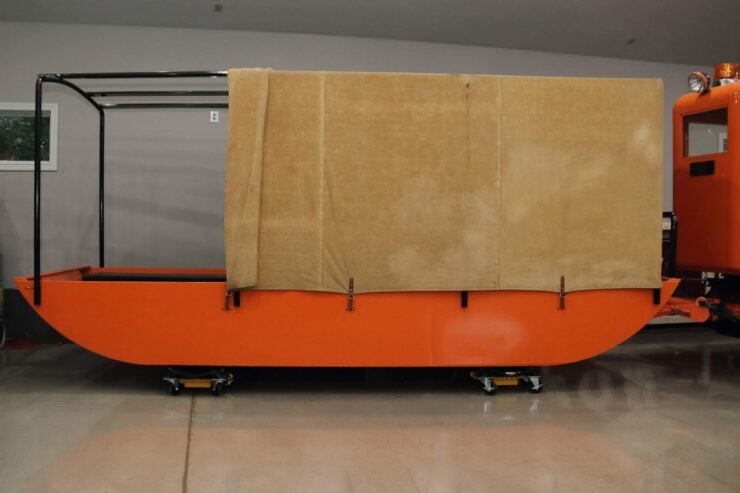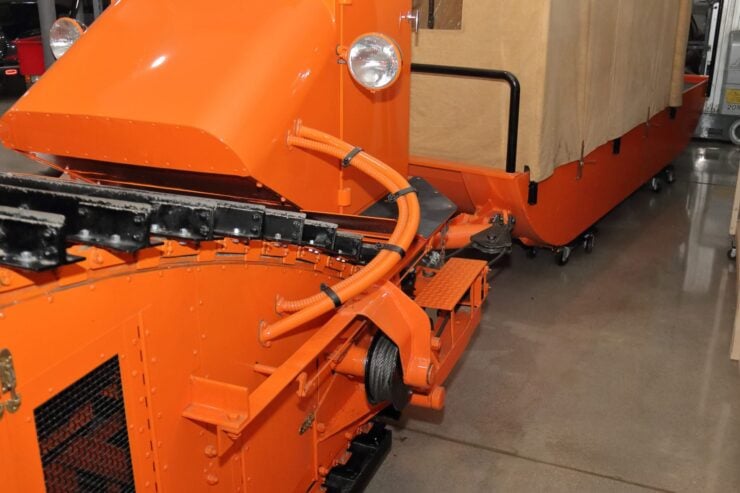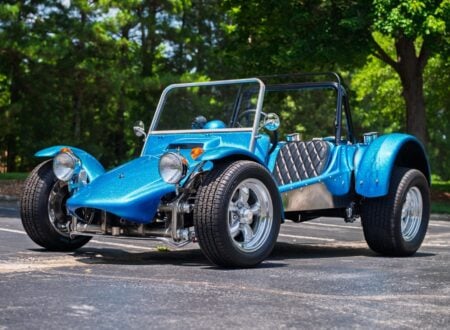This is the last surviving Monarch Sno-Motor, it’s a strange looking machine that proved highly capable – traveling deep snow hauling lumber, and later carrying skiers up slopes as steep as 40º.
The Sno-Motor is made up of two distinct halves, the tracked front section contains the engine and transmission, with the driver’s cab on the back. The rear section is permanently attached, allowing the vehicle to haul loads and acting as a fulcrum point when it needs to turn.
Fast Facts – The Monarch Sno-Motor
- The Monarch Sno-Motor, designed in the 1930s by T.P. Flynn, was built for snow travel and lumber hauling. It featured a front-tracked section with a 90 bhp Hercules engine and could carry up to 2.5 tons of cargo or 18 people, making it ideal for deep snow transportation.
- Unlike traditional snow vehicles, the Sno-Motor used a front tracked section and rear-mounted driver cabin, with steering achieved by pivoting the sled it towed. It was widely used for hauling skiers, rescuing injured skiers, and even aiding in avalanche rescues in the mountains.
- The Monarch Sno-Motor was produced by Monarch Forge and Machine Works in Portland, Oregon. This particular machine was used in constructing the Mt. Hood Ski Lodge and was later employed for skiing-related activities.
- The last known surviving Monarch Sno-Motor shown here underwent a full restoration, including a rebuild of its Hercules engine. Now in excellent condition, it will be auctioned by Mecum in mid-January, along with vintage photos, documentation, and a trailer for transportation.
The Origins Of The Monarch Sno-Motor
The 1920s and 1930s were the early days of machines designed for transportation on the snow and ice, engineers around the world came up with a vast array of different solutions including Joseph-Armand Bombardier who developed some unusual propeller-driven machines in the 1910s.
Above Video: this clip shows the Monarch Sno-Motor being driven in the snow, and it showcases both the propulsion and the unusual steering mechanism.
Bombardier would of course become a familiar name for those who lived in places with winters that featured heavy snowfalls. He developed a remarkable array of snow vehicles like the Bombardier B7 “Snow Coach” that helped to revolutionize the lives of people in the far northern and southern latitudes.
While Joseph-Armand was hard at work developing his designs in the 1930s another engineer on the other side of the continent was carefully developing his own unique design. His name was T. P. Flynn and he was working on a new vehicle that would be called the Sno-Motor.
The Sno-Motor: How It Works
Flynn’s design was remarkably different to the designs from Bombardier, rather than use twin front skis for steering with rear tracks for propulsion the Sno-Motor would use a wide single track front end, a rear mounted driver cabin, and it would have a sled towed behind.
Interestingly, steering is accomplished by turning the sled relative to the front end, it acts as a fulcrum point to provide directional control whilst also being able to carry up to 2.5 tons of cargo or 18+ people.
Power is provided by a 90 hp Hercules flathead six-cylinder engine which is contained within the front tracked section, its considerable weight also helps with traction on loose snow. There are access doors on either side of the tracked section to allow access for mechanics, so that checks and maintenance can be performed.
 The front half of the Monarch Sno-Motor holds the engine and transmission with the driver’s cab on the back, the rear half was originally used for hauling lumber, then later converted for carrying skiers up the slopes.
The front half of the Monarch Sno-Motor holds the engine and transmission with the driver’s cab on the back, the rear half was originally used for hauling lumber, then later converted for carrying skiers up the slopes.The front section is 56 inches wide, or 4.6 feet, and it has steel plates attached to the tracks to ensure good grip into the snow and ice. The Sno-Motor proved adept at crossing even deep fresh snow, some operators apparently learned to drive it back and forth over particularly soft sections to compact it and make crossing it easier.
A Working Life In The Mountains
The Sno-Motor was built by the Monarch Forge and Machine Works of Portland, Oregon to Flynn’s design. A number of different versions were built over the years and the example you see here is thought to be the last surviving Sno-Motor in the world.
This machine was initially used in the construction of the Mt Hood Ski Lodge, after which time it was used primarily for hauling skiers up the slopes and for rescuing injured skiers, bringing them back down the mountain where they could receive medical treatment and be transferred to hospital.
One other, less common, usage was avalanche rescues. Due to the fact that the Sno-Motor could traverse almost any terrain it was used after avalanches to find survivors, recover bodies, and in 1949 it was used by scientists who were studying avalanches to better predict them.
The Monarch Sno-Motor Shown Here
As noted higher up, the Monarch Sno-Motor you see here is the last one left in the world – well it’s the last one that anyone knows about, though there is always a chance that there may be another one or two rusting in rural barns under a tarp somewhere.
This one was given a comprehensive restoration by George Schaaf and his team after he bought it from a collection in Lake Tahoe. This restoration included a rebuild of the straight-six Hercules flathead 90 bhp engine and its transmission.
 Power is provided by a reliable Hercules straight-six flathead producing 90 bhp.
Power is provided by a reliable Hercules straight-six flathead producing 90 bhp.It’s now being offered for sale for the first time in a handful of years, with moving dollies included, as well as vintage photos and documentation, a trailer, and a bill of sale.
It’s now due to roll across the auction block with Mecum in mid-January. If you’d like to read more about it or register to bid you can visit the listing here.
Images courtesy of Mecum


























